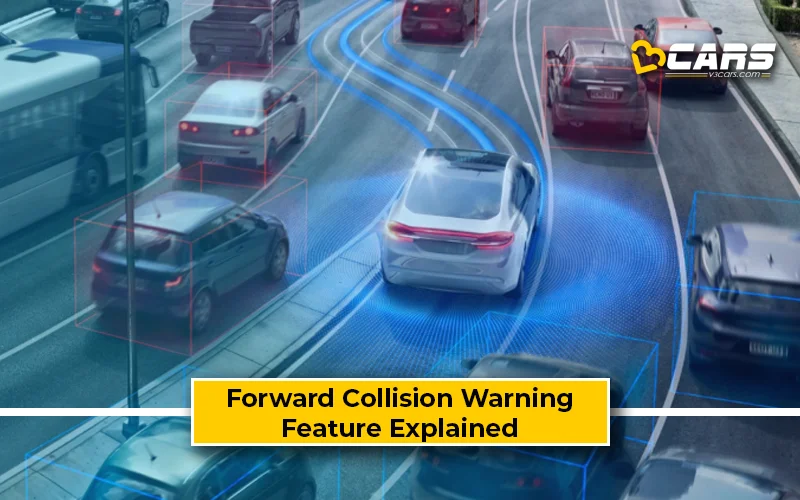Forward Collision Warning (FCW) – ADAS Feature Explained
As cars equipped with Advanced Driver Assistance Systems (ADAS) get ever so popular, we take a look at specific safety features built into the suite, such as forward collision warning. Often abbreviated to FCW in brochures and manual, forward collision warning is a safety feature built to alert drivers to potential hazards ahead. In this article, we take a look at what FCW is, how it functions, its advantages and disadvantages, and its availability in the Indian market.

What Is Forward Collision Warning?
Forward Collision Warning (FCW) is a driver-assistance system that monitors the road ahead of your car and alerts you if it detects a potential collision with a vehicle or obstacle in your path. It’s designed to give the driver a heads-up, giving them enough time to take evasive action, such as braking or steering, to avoid an accident.
How Does Forward Collision Warning Work?
FCW systems use a combination of sensors to continuously scan the road ahead:
- Sensors: These systems employ radar, lidar or cameras (or a combination of these) mounted at the front of the vehicle, such as behind the grille, bumper or on the windshield.
- Monitoring: These sensors constantly measure the distance to vehicles or objects in front of your car and track their speed relative to yours.
- Risk Assessment: An electronic control unit (ECU) processes this data in real-time. It calculates if your vehicle is approaching an obstacle too quickly, creating a risk of collision.
- Alerts: If a potential collision is detected, the system triggers warnings to the driver. These alerts can be visual (flashing light or icon), audible (beeps or chimes), or haptic (vibrations in the steering wheel or seat base)
- Integration with AEB (Optional): Many vehicles with FCW also come with Automatic Emergency Braking (AEB). If the driver doesn’t respond to the FCW alerts, AEB automatically applies the brakes to help prevent or reduce the severity of a collision.
Also Read: Autonomous Emergency Braking (AEB) – Feature Explained
What Are The Pros And Cons Of Forward Collision Warning?
Here are the pros of forward collision warning:
- Accident Prevention: FCW provides extra reaction time, helping drivers avoid rear-end collisions or other frontal impacts.
- Enhanced Safety: It acts as an additional layer of protection, especially when a driver’s attention might momentarily lapse.
- Tailgating Alerts: Some systems can also warn if you are following another vehicle too closely, promoting safer driving distances.
Here are the cons of forward collision warning:
- False Alarms: The system might occasionally trigger false warnings due to objects on the roadside, sudden lane changes by other vehicles, or specific environmental conditions (like heavy rain or snow affecting sensors).
- Sensor Limitations: Performance can be affected by adverse weather conditions (heavy fog, rain, snow, or direct sunlight) that obscure the sensors or camera.
- Driver Complacency: Over-reliance on FCW could lead to drivers becoming less attentive to the road, assuming the system will always intervene. It’s important to remember FCW is an assistance system, not a substitute for attentive driving.
- Added Vehicle Cost: FCW is typically part of the ADAS suite, which increases the overall price of the vehicle.
Can Forward Collision Warning Be Installed From The Aftermarket?
Yes, aftermarket Forward Collision Warning systems are available. These systems typically use cameras or radar sensors that can be mounted on your vehicle. They aim to provide similar alerts (visual, audible) to factory-installed systems.
However, aftermarket installations might vary in reliability and lack AEB integration. They will also need professional installation.
Affordable Cars in India That Offer Forward Collision Warning?
Forward Collision Warning is becoming increasingly common in the Indian market, often as part of an ADAS suite. Here are some cars in India (mostly in higher variants) that offer FCW as of mid-2025:
- Mahindra XUV 3XO
- Honda Amaze
- Hyundai Venue
- Honda City
- Kia Sonet
- Hyundai Creta
- Mahindra Scorpio-N
Also Read: Hill Descent Control – Feature Explained
Helpful Tools:
- Fuel Cost Calculator for Cars – Know your monthly fuel expense based on usage and mileage
- Car On-Road Price Calculator – Convert ex-showroom to on-road price for any city
Sell Used Car Online – Enter your car and contact details to get an instant price estimate and book a free inspection with our partner network


0 Comments